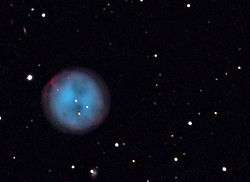Owl Nebula
| Nebula | |
|---|---|
|
Owl Nebula | |
| Observation data: J2000.0 epoch | |
| Right ascension | 11h 14m 47.734s[1] |
| Declination | +55° 01′ 08.50″[1] |
| Distance | 2,030 ly (621 pc)[2] ly |
| Apparent magnitude (V) | +9.9 |
| Apparent dimensions (V) | 3′.4 × 3′.3 |
| Constellation | Ursa Major |
| Physical characteristics | |
| Radius | 0.91 ly (0.28 pc)[3] ly |
| Notable features | Owl-like "eyes" visible through larger telescopes |
| Designations | M97, NGC 3587, PN G148.4+57.0 |
The Owl Nebula (also known as Messier 97, M97 or NGC 3587) is a planetary nebula located approximately 2,030 light years away in the constellation Ursa Major.[2] It was discovered by French astronomer Pierre Méchain on February 16, 1781.[4] When William Parsons, 3rd Earl of Rosse, observed the nebula in 1848, his hand-drawn illustration resembled an owl's head. It has been known as the Owl Nebula ever since.[5]
The nebula is approximately 8,000 years old.[6] It is approximately circular in cross-section with a little visible internal structure. It was formed from the outflow of material from the stellar wind of the central star as it evolved along the asymptotic giant branch.[3] The nebula is arranged in three concentric shells, with the outermost shell being about 20–30% larger than the inner shell.[7] The owl-like appearance of the nebula is the result of an inner shell that is not circularly symmetric, but instead forms a barrel-like structure aligned at an angle of 45° to the line of sight.[3]
The nebula holds about 0.13 solar masses of matter, including hydrogen, helium, nitrogen, oxygen, and sulfur;[3] all with a density of less than 100 particles per cubic centimeter.[7] Its outer radius is around 0.91 ly (0.28 pc) and it is expanding with velocities in the range of 27–39 km/s into the surrounding interstellar medium.[3]
The 14th magnitude central star has since reached the turning point of its evolution where it condenses to form a white dwarf.[4][7] It has 55–60% of the Sun's mass, 41–148 times the brightness of the Sun,[3] and an effective temperature of 123,000 K.[8] The star has been successfully resolved by the Spitzer Space Telescope as a point source that does not show the infrared excess characteristic of a circumstellar disk.[9]
See also
References
- 1 2 Kerber, F.; et al. (September 2003), "Galactic Planetary Nebulae and their central stars. I. An accurate and homogeneous set of coordinates", Astronomy and Astrophysics, 408: 1029–1035, Bibcode:2003A&A...408.1029K, doi:10.1051/0004-6361:20031046.
- 1 2 Stanghellini, Letizia; et al. (December 2008), "The Magellanic Cloud Calibration of the Galactic Planetary Nebula Distance Scale", The Astrophysical Journal, 689 (1): 194–202, arXiv:0807.1129
 , Bibcode:2008ApJ...689..194S, doi:10.1086/592395.
, Bibcode:2008ApJ...689..194S, doi:10.1086/592395. - 1 2 3 4 5 6 Cuesta, L.; Phillips, J. P. (November 2000), "Excitation and Density Mapping of NGC 3587", The Astrophysical Journal, 120 (5): 2661–2669, Bibcode:2000AJ....120.2661C, doi:10.1086/316800.
- 1 2 Jones, Kenneth Glyn (1991), Messierś Nebulae and Star Clusters (2nd ed.), Cambridge University Press, pp. 277–279, ISBN 0521370795.
- ↑ Clark, Roger Nelson (1990), Visual Astronomy of the Deep Sky, CUP Archive, ISBN 0521361559.
- ↑ Per Guerrero et al. (2003), the age is 12,900 × d years, where d is the distance in kpc. According to Stanghellini et al. (2008), d is 0.621 kpc. Hence, the age is 12,900 × 0.621 ≈ 8,000 years.
- 1 2 3 Guerrero, Martín A.; et al. (June 2003), "Physical Structure of Planetary Nebulae. I. The Owl Nebula", The Astrophysical Journal, 125 (6): 3213–3221, arXiv:astro-ph/0303056
 , Bibcode:2003AJ....125.3213G, doi:10.1086/375206.
, Bibcode:2003AJ....125.3213G, doi:10.1086/375206. - ↑ Capriotti, Eugene R.; Kovach, William S. (March 1968), "Effective Temperatures of the Central Stars of Planetary Nebulae", Astrophysical Journal, 151 (5): 991–995, Bibcode:1968ApJ...151..991C, doi:10.1086/149498.
- ↑ Bilíková, Jana; et al. (May 2012), "Spitzer Search for Dust Disks around Central Stars of Planetary Nebulae", The Astrophysical Journal Supplement, 200 (1): 3, Bibcode:2012ApJS..200....3B, doi:10.1088/0067-0049/200/1/3.
External links
- The Owl Nebula @ SEDS Messier pages
- The Owl Nebula at Calar Alto Observatory
- NightSkyInfo.com – M97, the Owl Nebula
- The Owl Nebula on WikiSky: DSS2, SDSS, GALEX, IRAS, Hydrogen α, X-Ray, Astrophoto, Sky Map, Articles and images
- Norton, Andy; Crowther, Paul; Hardy, Liam. "M97 – Owl Nebula". Deep Space Videos. Brady Haran.
- The Owl Nebula (M97) at Constellation Guide
Coordinates: ![]() 11h 14.8m 00s, +55° 01′ 00″
11h 14.8m 00s, +55° 01′ 00″

